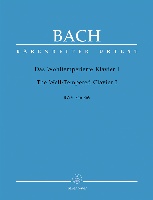Am Abend aber desselbigen Sabbats (On the evening,
however, of the same Sabbath), BWV 42,[a] is a church
cantata by Johann Sebastian Bach. He composed the
cantata in Leipzig for the first Sunday after Easter,
called Quasimodogeniti. He composed it in his second
annual cycle, which consisted of chorale cantatas since
the first Sunday after Trinity of 1724. Bach ended the
sequence on Palm Sunday of 1725, this cantata is not a
chorale cantata and the only cantata in the second
cycle to begin with a...(+)
Am Abend aber desselbigen Sabbats (On the evening,
however, of the same Sabbath), BWV 42,[a] is a church
cantata by Johann Sebastian Bach. He composed the
cantata in Leipzig for the first Sunday after Easter,
called Quasimodogeniti. He composed it in his second
annual cycle, which consisted of chorale cantatas since
the first Sunday after Trinity of 1724. Bach ended the
sequence on Palm Sunday of 1725, this cantata is not a
chorale cantata and the only cantata in the second
cycle to begin with an extended sinfonia.
After the quote from the Gospel of John, the poet
paraphrases, in movement 3, words of Jesus from the
Gospel of Matthew, Matthew 18:20, "Wo zwei oder drei
versammelt sind in meinem Namen, da bin ich mitten
unter ihnen" (For where two or three are gathered
together in my name, there am I in the midst of
them).
Bach first performed the cantata on 8 April 1725, and
again in Leipzig at least twice, on 1 April 1731 and
either on 1 April 1742 or on 7 April 1743.
Possibly Bach took the opening sinfonia from earlier
music. Dürr believes that it is a movement from an
instrumental concerto. It is a kind of "concerto a due
cori", the strings interacting with a concertino of the
woodwinds, oboes and bassoon. The two groups first
introduce their own lively themes, which are distinct
but related to each other. Then they also exchange
their themes and play together. The middle section
begins with a surprising new motif for oboe and
bassoon, which Bach himself marked "cantabile". Julian
Mincham sees a close resemblance to the opening
movements to concerti such as those for violin, BWV
1042, and keyboard, BWV 1053. According to John Eliot
Gardiner, this movement and the first aria are both
taken from Bach's congratulatory cantata Der Himmel
dacht auf Anhalts Ruhm und Glück, BWV 66a, celebrating
the 24th birthday of Leopold, Prince of Anhalt-Köthen
on 10 December 1718.
The Bible quote is sung in recitative by the tenor as
the Evangelist, accompanied by the continuo in repeated
fast notes, possibly illustrating the anxious heart
beat of the disciples, when Jesus appears, "On the
evening, however, of the same Sabbath, when the
disciples had gathered and the door was locked out of
fear of the Jews, Jesus came and walked among
them".
In movement 3, an aria marked adagio, the repetition is
kept in the bassoon, but the strings hold long chords
and the oboes play extended melodic lines. According to
Dürr, it may have been another movement from the same
concerto that movement 1 relies on.
Bach composed the chorale text of movement 4, "Do not
despair, o little flock", as a duet, accompanied only
by the continuo including bassoon. Fragments of the
usual chorale theme, "Kommt her zu mir, spricht Gottes
Sohn", can be detected occasionally. Terry interprets
that the bassoon obbligato was intended to accompany a
chorale melody which "never actually sounded",
conveying the "hiddenness" of the church in the
world.
The bass prepares in a recitative, ending as an arioso,
the last aria, which is accompanied by the divided
violins and the continuo. The theme is again a contrast
between the "Unruhe der Welt" (restlessness of "the
world") and "Friede bei Jesus" (peace with Jesus).
While the instruments play in wild motion, the bass
sings a calm expressive melody, only accenting the word
"Verfolgung" (persecution) by faster motion in long
melismas. According to Mincham, this aria might go back
to a different movement from the same concerto as the
sinfonia.
The chorale theme of Luther's chorale was published by
Martin Luther in the Kirchē gesenge, mit vil
schönen Psalmen unnd Melodey (edited by Johann
Walter), published in Nürnberg in 1531), and then in
the Geistliche Lieder by Joseph Klug (Wittenberg,
1535). The melody of the additional stanza (Gieb unsern
Fürsten) was first published in Das christlich
Kinderlied D. Martini Lutheri in Wittenberg, 1566. Bach
set it for four parts.
The cantata in seven movements is scored for soprano,
alto, tenor, and bass soloists, a four-part choir only
in the closing chorale, two oboes, bassoon, two
violins, viola and basso continuo. The reason for the
choir appearing only in the closing chorale may have
been that the Thomanerchor had been in high demand
during the Holy Week and Easter, performing Wie schön
leuchtet der Morgenstern, BWV 1, the St John Passion
and Christ lag in Todes Banden, BWV 4, among
others.
Source: Wikipedia
(https://en.wikipedia.org/wiki/Am_Abend_aber_desselbige
n_Sabbats,_BWV_42).
I created this arrangement of the last (third) Aria:
"Jesus ist ein Schild der Seinen" (Jesus is the shield
of His own) for French Horn & Concert (Pedal) Harp.





 Faire un don
Faire un don